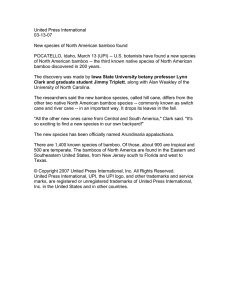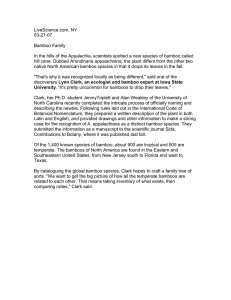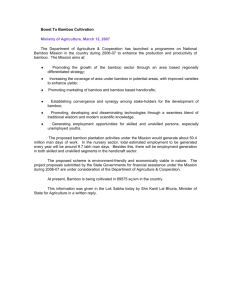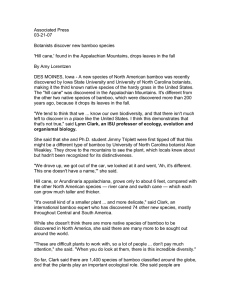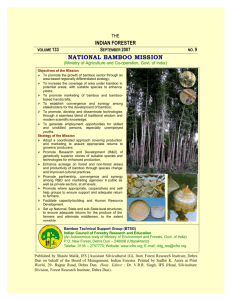A PRELIMINARY STUDY ON THE METHOD FOR EXTRACTING BAMBOO GROVES
advertisement
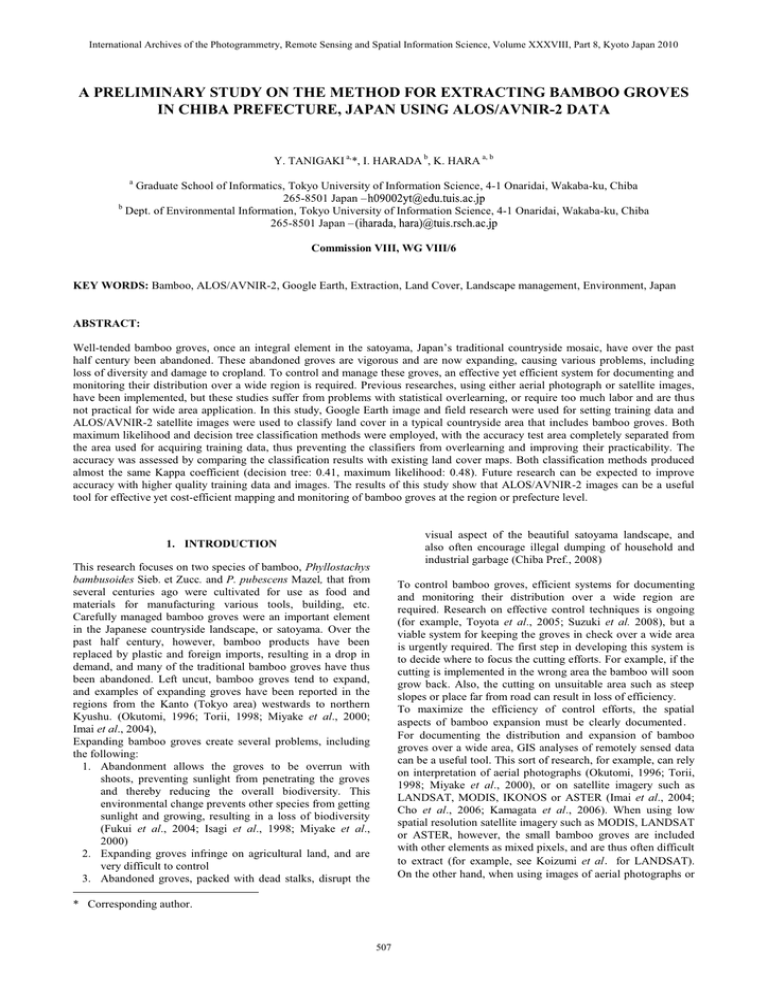
International Archives of the Photogrammetry, Remote Sensing and Spatial Information Science, Volume XXXVIII, Part 8, Kyoto Japan 2010 A PRELIMINARY STUDY ON THE METHOD FOR EXTRACTING BAMBOO GROVES IN CHIBA PREFECTURE, JAPAN USING ALOS/AVNIR-2 DATA Y. TANIGAKI a,*, I. HARADA b, K. HARA a, b a Graduate School of Informatics, Tokyo University of Information Science, 4-1 Onaridai, Wakaba-ku, Chiba 265-8501 Japan – xxxxxxxxxxxxxxxxxxxx b Dept. of Environmental Information, Tokyo University of Information Science, 4-1 Onaridai, Wakaba-ku, Chiba 265-8501 Japan – xxxxxxxxxxxxxXXXxxxxxxx Commission VIII, WG VIII/6 KEY WORDS: Bamboo, ALOS/AVNIR-2, Google Earth, Extraction, Land Cover, Landscape management, Environment, Japan ABSTRACT: Well-tended bamboo groves, once an integral element in the satoyama, Japan’s traditional countryside mosaic, have over the past half century been abandoned. These abandoned groves are vigorous and are now expanding, causing various problems, including loss of diversity and damage to cropland. To control and manage these groves, an effective yet efficient system for documenting and monitoring their distribution over a wide region is required. Previous researches, using either aerial photograph or satellite images, have been implemented, but these studies suffer from problems with statistical overlearning, or require too much labor and are thus not practical for wide area application. In this study, Google Earth image and field research were used for setting training data and ALOS/AVNIR-2 satellite images were used to classify land cover in a typical countryside area that includes bamboo groves. Both maximum likelihood and decision tree classification methods were employed, with the accuracy test area completely separated from the area used for acquiring training data, thus preventing the classifiers from overlearning and improving their practicability. The accuracy was assessed by comparing the classification results with existing land cover maps. Both classification methods produced almost the same Kappa coefficient (decision tree: 0.41, maximum likelihood: 0.48). Future research can be expected to improve accuracy with higher quality training data and images. The results of this study show that ALOS/AVNIR-2 images can be a useful tool for effective yet cost-efficient mapping and monitoring of bamboo groves at the region or prefecture level. visual aspect of the beautiful satoyama landscape, and also often encourage illegal dumping of household and industrial garbage (Chiba Pref., 2008) 1. INTRODUCTION This research focuses on two species of bamboo, Phyllostachys bambusoides Sieb. et Zucc. and P. pubescens Mazel, that from several centuries ago were cultivated for use as food and materials for manufacturing various tools, building, etc. Carefully managed bamboo groves were an important element in the Japanese countryside landscape, or satoyama. Over the past half century, however, bamboo products have been replaced by plastic and foreign imports, resulting in a drop in demand, and many of the traditional bamboo groves have thus been abandoned. Left uncut, bamboo groves tend to expand, and examples of expanding groves have been reported in the regions from the Kanto (Tokyo area) westwards to northern Kyushu. (Okutomi, 1996; Torii, 1998; Miyake et al., 2000; Imai et al., 2004),㻌 Expanding bamboo groves create several problems, including the following: 1. Abandonment allows the groves to be overrun with shoots, preventing sunlight from penetrating the groves and thereby reducing the overall biodiversity. This environmental change prevents other species from getting sunlight and growing, resulting in a loss of biodiversity (Fukui et al., 2004; Isagi et al., 1998; Miyake et al., 2000) 2. Expanding groves infringe on agricultural land, and are very difficult to control 3. Abandoned groves, packed with dead stalks, disrupt the To control bamboo groves, efficient systems for documenting and monitoring their distribution over a wide region are required. Research on effective control techniques is ongoing (for example, Toyota et al., 2005; Suzuki et al. 2008), but a viable system for keeping the groves in check over a wide area is urgently required. The first step in developing this system is to decide where to focus the cutting efforts. For example, if the cutting is implemented in the wrong area the bamboo will soon grow back. Also, the cutting on unsuitable area such as steep slopes or place far from road can result in loss of efficiency. To maximize the efficiency of control efforts, the spatial aspects of bamboo expansion must be clearly documented㸬 For documenting the distribution and expansion of bamboo groves over a wide area, GIS analyses of remotely sensed data can be a useful tool. This sort of research, for example, can rely on interpretation of aerial photographs (Okutomi, 1996; Torii, 1998; Miyake et al., 2000), or on satellite imagery such as LANDSAT, MODIS, IKONOS or ASTER (Imai et al., 2004; Cho et al., 2006; Kamagata et al., 2006). When using low spatial resolution satellite imagery such as MODIS, LANDSAT or ASTER, however, the small bamboo groves are included with other elements as mixed pixels, and are thus often difficult to extract (for example, see Koizumi et al㸬for LANDSAT). On the other hand, when using images of aerial photographs or * Corresponding author. This is useful to know for communication with the appropriate person in cases with more than one author. 507 International Archives of the Photogrammetry, Remote Sensing and Spatial Information Science, Volume XXXVIII, Part 8, Kyoto Japan 2010 high spatial resolution satellite such as IKONOS or QuickBird, the area of a single scene is small. As a result, when applying these images to a wide area such as a prefecture, the cost required for orthorectifying the images and calibrating DN (= pixel value in this study) are high. In addition, in many previous studies the training area (area included in polygon showing land cover for which training data was established) and the area used for checking accuracy are insufficiently defined. In some cases, it is even impossible to verify that these two areas are separate. Another problem is that bamboo groves are no longer considered critical bamboo groves are no longer considered a critical issue for our life and thus funding for control programs is limited, requiring a costeffective method for extracting the groves. Given this urgent need for effective and efficient mapping of bamboo groves over a wide area, this research develops a system using ALOS AVNIR-2 satellite imagery and Google Earth images (Google, 2009) to acquire training data. The wide area classification is then implemented utilizing the same ALOS/AVNIR-2 imagery. In this study, the high spatial resolution of the imagery prevents many problems with mixel; while the wide area covered by each scene reduces the amount of work required for orthorectification and DN calibration. 2. 3. 4. 5. 6. 2.3 Orthorectifiation of Satellite Imagery Intersections from the Road/Rail Line data were used as reference to set GCPs for orthorectifying the ALOS/AVNIR-2 images. In general, it might be assumed that in cases like this Google Earth images would produce smaller gaps between the reference data and ALOS/AVNIR-2 images. In this research, however, distinct landmarks that could be recognized were very few, making accurate setting of GCPs difficult. In addition, the target bamboo groves were small in size, and usually widely separated from one another. As a result, using Google Earth images as reference would require a great deal of time setting GCPs for each of the many training areas, resulting in a large effort in proportion to the amount and quality of the acquired training data. The images were orthorectified so that the gap between the reference and images was less than 10m. The ortho images include RGB and infrared for four periods (August and November 2007; and February and April 2008), producing 16 layers. In addition, NDVI was calculated for each period, bringing the total to 20 layers for each adjusted AVNIR-2 images. 2. METHOD 2.1 Study Area The research was implemented in a 25km15km target area located in northern part of Chiba Prefecture, on the outskirts of Tokyo (Figure 1). The geology in the area consists of flattopped uplands and narrow alluvial valleys. Traditional landuse patterns feature rice paddies on the valley floor and various woodlands, including bamboo groves, on the slopes and uplands. The training data was obtained from land covers including bamboo within the area, and the accuracy check was performed in the Azeta area (Figure 1), where several narrow valleys cut deep into the uplands. 2.4 Setting Training Data In general, land classification accuracy is high when the accuracy check is implemented in the same area where the training data is obtained. This accuracy, however, is often due to overlearning rather than true accuracy in classification. In these cases, the accuracy scores will drop if the check is performed outside the training area. To avoid this problem, the accuracy check was performed in an area separate from the training areas in this research. Based on field data and Google Earth images, training areas for the following land covers were set; bamboo grove, bare land, water, urban, grass and paddy field, deciduous forest and evergreen forest. All gaps between the intersections in the Road-Rail Line Data and Google Earth images was equal to or less than 10 meters. As a result, the gap between the adjusted AVNIR-2 images and the Google Earth images were equal to or less than 20m (Figure 2). To reduce the effect of these gaps, all training areas were shrunk by 20 meter (Figure 3). Finally, training data was built using adjusted AVNIR-2 images from the training areas (Figure 1, Table 1). 4km Sea Study area August, 2007; 15 November, 2007; 15 February, 2008; 1 April, 2008) 10m grid DEM (GSI, 2009) Road/Rail Line vector data on 1/2500 scale (GSI, 2007) Images of Google Earth 5.0 (Google, 2009) which the Google Earth indicated that is taken on 31 December, 2004 Field survey data, utilized for setting training area and modifying existing vegetation map for accuracy check Modified vegetation map made of field survey results and existing vegetation maps (Emura et al., 2009) to estimate accuracy of land cover classifiers (Figure 4) Training area Accuracy check area Figure 1. Location of study area, training areas and accuracy check area Table 1. Number of training areas and total area for each land cover category 2.2 Data The following 6 types of data were utilized 1. ALOS/AVNIR-2 radiometric calibrated RGB and near infrared imagery through utilizing stable light source in the satellite (10m spatial resolution, acquired on 15 508 Deciduous Water Grass & Bare Dry field Urban paddy field land Bamboo Evergreen total area 䠄ha䠅 1.14 1.4 1.1 546.4 20.8 9.6 36.9 0.8 number 26 3 10 3 1 6 1 6 International Archives of the Photogrammetry, Remote Sensing and Spatial Information Science, Volume XXXVIII, Part 8, Kyoto Japan 2010 (a) (b) Bamboo on the vegetation map Boundaries of land covers in the vegetation map Bamboo Evergreen Deciduous Grass and paddy field Dry field Bare land Water Urban 500 m N Figure 4. (a) Aerial photograph taken in 27 January 2008 (© Keiyo Survey) overlayed by boundaries of land covers categoies in the modified vegetation map on the right and (b) the modified vegetation map㻌 Bamboo in adjusted AVNIR-2 images Training area for bamboo made from Google Earth images Bamboo in adjusted AVNIR-2 images Training area of bamboo made from Google Earth images Real position of bamboo Evergreen in adjusted AVNIR-2 images Evergreen in adjusted AVNIR-2 images New training area of bamboo made through shrinking old training area of bamboo by 20m Figure 3. An example of training areas including only target land cover category (bamboo) in adjusted AVNIR-2 image resulting from training areas shrunk by 20 meters Figure 2. An example of training areas including non-target land cover category (evergreen forest) showing positional gaps between training areas and adjusted AVNIR-2 images 2.5 Supervised Land Cover Classifications 2.6 Accuracy Check Two classifications were performed and compared; one using the maximum likelihood classifier (MLC) which assume s normal distribution of DN and equal probability of each land cover (for example; Wadachi et al., 1976); and the other a decision tree classifier (DTC), employing the well-tested Gini coefficient and CART algorithms (Breiman et al., 1984). The condition for leaf pruning was Accuracies of MLC and DTC were assessed from the error matrixes, including the Kappa Coefficient (Cohen, 1960), which was calculated by comparing the classification results to the vegetation map. In addition, to confirm the importance of separating the training and accuracy check area, DTC and MLC accuracy checks were carried out utilizing the training data instead of the vegetation map. Al / At < 0.01 Where 3. RESULTS (1) 3.1 Training Data Al = area assigned to the leaf At = total area in training areas occupied by the same land cover as that of the leaf The distributions of DN and NDVI for each land cover class are shown in Figure 5. With the exception of a few instances, such as DN for February 2008, a clear separation appeared between bamboo groves and other land cover categories, 509 International Archives of the Photogrammetry, Remote Sensing and Spatial Information Science, Volume XXXVIII, Part 8, Kyoto Japan 2010 15th Aug.2007 Bamboo Evergreen Deciduous Grass and paddy field Dry field Bare land Water Urban 㻥㻜 㻝㻞㻜 㻝㻡㻜 㻢㻜 㻝㻜㻡 㻝㻡㻜 㻟㻜 㻝㻝㻜 㻝㻥㻜 㻝㻜 㻤㻡 㻝㻢㻜 㻙㻜㻚㻢 㻙㻜㻚㻟 㻜 㻜㻚㻟 㻜㻚㻢 15th Nov.2007 Bamboo Evergreen Deciduous Grass and paddy field Dry field Bare land Water Urban 㻢㻜 㻤㻜 㻝㻜㻜 㻠㻜 㻢㻜 㻤㻜 㻞㻡 㻡㻜 㻣㻡 㻝㻜 㻢㻜 㻝㻝㻜 㻙㻜㻚㻢 㻙㻜㻚㻟 㻜 㻜㻚㻟 㻜㻚㻢 15th Feb.2008 Bamboo Evergreen Deciduous Grass and paddy field Dry field Bare land Water Urban 㻢㻜 㻤㻡 㻝㻝㻜 㻟㻜 㻢㻜 㻥㻜 㻞㻜 㻢㻜 㻝㻜㻜 㻜 㻡㻡 㻝㻝㻜 㻙㻜㻚㻢 㻙㻜㻚㻟 㻜 㻜㻚㻟 㻜㻚㻢 1st Apr.2008 Bamboo Evergreen Deciduous Grass and paddy field Dry field Bare land Water Urban 㻤㻜 㻝㻝㻜 DN of Blue 㻝㻠㻜 㻡㻜 㻤㻡 DN of Green 㻝㻞㻜 㻟㻜 㻣㻡 㻝㻞㻜 㻝㻜 DN of Red 㻡㻜 㻥㻜 DN of Infra red 㻙㻜㻚㻢 㻙㻜㻚㻟 㻜 㻜㻚㻟 㻜㻚㻢 NDVI 5 25 50(median) 75 9 5 Percentile Figure 5. Box plots indicating distribution of RGB’s DN and NDVI in training data for each day and land cover category indicating that data and method used in this study have the capability of extracting bamboo groves. 4. DISCUSSION 3.2 Land Cover Classifications 4.1 Low NDVI of Vegetation in April The results of classifications by MLC and DTC are shown in Figure 6, and the error matrixes in Table 2 and Table 3. As a whole, DTC showed a lower sensibility towards the bamboo groves, but a higher specificity. The Kappa coefficient indicating overall accuracy for both methods was essentially the same, with only minor differences which could vary from place to place. In addition, the Kappa coefficient for bamboo (DTC: 0.81, MLC: 0.97) and overall Kappa coefficient (DTC: 0.97, MLC: 0.98) were very high when the accuracy check area was set in the training area. Table 2 and Table 3, however, indicate that deciduous forest, evergreen forest, and grass and paddy field are difficult to distinguish from bamboo. Also, when the MLC was implemented without shrinking the training area, almost all land covers were recognized as bamboo. In the training data, NDVI in April 2008 was less than that in February 2007 (Figure 5). NDVI for all land cover categories in April approached -0.4 despite radiometric calibration utilizing stable light source in AVNIR-2. This may be due to yellow sand because April is the month in which the most yellow sand was blown from China to Japan (Japan Meteorological Agency, 2008a). Therefore, sand in the upper atmosphere may have caused NDVI for all the categories to approach -0.4, which may be the value for the yellow sand, though yellow sand wasn’t observed at 1 April 2008 by the point which is on the ground and nearest to training areas (Japan Meteorological Agency, 2008b). This NDVI’s approach occurred in the training data may be responsible for low accuracy in classifiers that rely on seasonal differences in DN and NDVI values. However, classifiers in this study use only DN and NDVI’s hierarchical relationships among seasons and thus are not affected by the approach. 510 International Archives of the Photogrammetry, Remote Sensing and Spatial Information Science, Volume XXXVIII, Part 8, Kyoto Japan 2010 (a) (b) Bamboo Bamboo on the vegetation map Evergreen Deciduous Grass and paddy field Dry field Bare land Water Urban 500 m N Figure 6. Results of maximum likelihood classification (a) and decision tree classification (b) of land covers utilizing adjusted AVNIR-2 images Table 2. Error matrix of maximum likelihood classifier Name and area of landcover in vegetation map (unit : ha) Total User's Kappa area Accuracy coefficient Grass & Dry Bare Bamboo Evergreen Deciduous Water Urban (ha) (%) (Cohen) paddy field field land Bamboo 16.51 4.13 7.84 1.24 0.53 0.12 0.00 0.94 31.31 0.53 0.48 Evergreen 5.14 12.74 6.36 0.17 0.17 0.02 0.00 0.19 24.79 0.51 0.47 Deciduous 2.72 3.16 31.53 4.84 0.29 0.21 0.00 0.34 43.09 0.73 0.52 Grass & paddy field 2.33 1.15 4.69 49.74 5.13 1.36 0.03 3.49 67.92 0.73 0.60 Dry field 0.86 1.18 5.56 10.28 16.49 1.00 0.11 5.17 40.65 0.41 0.35 Bare land 0.00 0.00 0.00 0.00 0.10 0.00 0.00 0.14 0.24 0.00 0.00 Water 0.00 0.00 0.00 0.00 0.00 0.00 0.00 0.00 0.00 0.00 Urban 3.31 2.56 5.52 8.32 12.61 2.53 0.80 56.40 92.05 0.61 0.61 Total area (ha) 30.87 24.92 61.50 74.59 35.32 5.24 0.94 66.67 300.05 Producer's 0.53 0.51 0.51 0.67 0.47 0.00 0.00 0.85 Accuracy(%) Overall Accuracy : 0.611 Overall Kappa Coefficeient (Cohen) : 0.522 Classified land cover Table 3. Error matrix of decision tree classifier Name and area of landcover in vegetation map (unit : ha) Total User's Kappa area Accuracy coefficient Grass & Dry Bare Bamboo Evergreen Deciduous Water Urban (ha) (%) (Cohen) paddy field field land Bamboo 11.90 2.48 3.12 2.43 0.12 0.14 0.05 0.49 20.73 0.57 0.41 Evergreen 8.43 14.22 11.59 1.19 1.01 0.12 0.02 0.63 37.21 0.38 0.40 Deciduous 5.70 5.42 39.21 17.16 3.18 1.03 0.19 3.66 75.55 0.52 0.45 Grass & paddy field 0.87 0.16 1.55 36.45 2.39 0.35 0.01 1.65 43.43 0.84 0.53 Dry field 3.03 1.78 4.62 12.81 23.89 2.25 0.39 13.66 62.43 0.38 0.40 Bare land 0.35 0.44 0.44 0.75 2.55 0.71 0.00 9.95 15.19 0.05 0.04 Water 0.00 0.00 0.01 0.12 0.40 0.00 0.25 0.16 0.94 0.27 0.26 Urban 0.52 0.51 1.01 3.66 1.78 0.62 0.03 36.44 44.57 0.82 0.58 Total area (ha) 30.80 25.01 61.55 74.57 35.32 5.22 0.94 66.64 300.05 Producer's 0.39 0.57 0.64 0.49 0.68 0.14 0.27 0.55 Accuracy(%) Overall Accuracy : 0.543 Overall Kappa Coefficeient (Cohen) : 0.454 Classified land cover 4.2 Importance of Shrinking in Setting Training Area 4.3 Importance of Separating Setting Training Area from Accuracy Check Area The MLC test implemented without shrinking recognized almost all land covers as bamboo, indicating the importance of shrinking the training area an adequate length when utilizing images which have a large positional gap. Although the Kappa coefficient for bamboo (DTC: 0.81, MLC: 0.97) and overall (DTC: 0.97, MLC: 0.98) was very high when the accuracy check area was set in training area, the Kappa coefficient for bamboo in the classifications were low (Table 2, 511 International Archives of the Photogrammetry, Remote Sensing and Spatial Information Science, Volume XXXVIII, Part 8, Kyoto Japan 2010 Isagi, Y., Torii, A., 1998. Range Expansion and its Mechanisms in a Naturalized Bamboo Species in Japan. Joumal of Sustainable Forestry, Vol.6, 1/2., pp. 127-141 Table 3). This indicates the importance of the separating training area from the accuracy check area. 4.4 Extraction Bamboo Okutomi, K., Shinoda, S., Fukuda, H., 1996. Cause analysis of the invasion of broad-leaves forest by bamboo on Japan. J. Vegetation Science 7, pp. 723-728 The results of this research showed that bamboo groves could be readily distinguished from most other land covers, but that some difficulty is experienced in distinguishing bamboo from other types of vegetation. The RGB and NDVI characteristics of bamboo are close to those of both deciduous and evergreen forest. In particular, willows and other deciduous trees on south facing slopes appear a similar color of light green to that of bamboo. In addition, both bamboo and evergreen forests are green in winter. Looking at the areas that were misclassified as bamboo, some evergreen forest in vegetation map were areas where bamboo was invading under a canopy formed of different trees. In the future, to improve the accuracy of this system, methods for obtaining higher quality training and image data, and for further orthorectifying the gaps between ground and sensed image positions, need be developed. Japan Meteorological Agency, 2009a. Successive change in the number of day when yellow sand came to Japan, Tokyo, Japan, in Japanese. http://www.data.kishou.go.jp/obsenv/kosahp/kosa_shindan.html (accessed 24 Dec. 2009) Japan Meteorological Agency, 2009b. The table of day and point in which yellow sand was observed in 2008, Tokyo, Japan, in Japanese. http://www.data.kishou.go.jp/obsenv/kosahp/kosa_table_2008.html (accessed 24 Dec. 2009) Kamagata, N., Hara, K., Mori, M., 2006. A new method of vegetation mapping by object-based classification using high resolution satellite data. Journal of the Japan Society of Photogrammetry and Remote Sensing, 45, 1., pp. 43-49 5. CONCLUSION Koizumi, K., Tanimoto, C., Piao, C., 2003. Extraction of Bamboo Stands by observing Landsat 5-TM. Journal of the Japan Society of Photogrammetry and Remote Sensing 42, 6., pp. 42-51 In this study, bamboo was extracted with 0.41-0.48 Kappa coefficient accuracy, with the classification for accuracy check implemented in an area completely separate from that used for setting training data. Although various technical issues need to be addressed to improve classification accuracy in future research, the results indicate that ALOS/AVNIR-2 and Google Earth images can be a useful tool for effective yet cost-efficient monitoring of Japan's expanding bamboo groves at the region or prefecture level. Miyake, N., Kawanishi, M., Mmiyake, M., Ishikawa, S., 2000. Expansion of bamboo forests in the Kitayama region, Kochi City, southwestern Japan, pp. I. Change in the area of the bamboo forests during the last 30 years. Hikobia 13, pp. 241252, in Japanese. Nishikawa, R., Murakami, T., Otsuki, K., Mizoue, N., Yoshida, S., 2006. Determining Seasonal Variation in Bamboo. Forest Spectral Reflectance Using Satellite and Ground-based Data. J.Jpn.For.Soc.88, pp. 473-481 ACKNOWLEDGMENTS The authors would like to thank Kazuyuki Takahashi and Kohei Emura of Tokyo University of Information Sciences (TUIS) for kindly allowing us to use their vegetation data in the accuracy test. We also thank Kevin Short of TUIS for his help on the English version of this paper. REFERENCES Suzuki, S., Kikuchi, A., Nakagoshi, N., 2008. Structure and species composition of regenerated vegetation after clear cutting of Phyllostachys pubescens culms. Japan Association for Landscape Ecology 12, 2., pp. 43-51, in Japanese. Breiman, L., Friedman, J. H., Olshen, R. A., Stone, C. J., 1984. Classification and regression trees. Wadsworth International Group, Califolnia. The Geospatial Information Authority of Japan, GSI., 2009. Base map information. http://fgd.gsi.go.jp/download/ (accessed 21 Jun. 2009) Chiba Prefecture, Japan., 2008. Prevention against spreading of bamboo and utilization of bamboo for materials. Chiba Prefecture, Japan., in Japanese. The Geospatial Information Authority of Japan (GSI), 2007. Digital Map 2500 (Spatial Data Framework) Toyota, N., Tokui, T., Matsuoka, S., 2005. Test for prevention against spreading of Phyllostachys pubescens -infusion of herbicide, clear-cutting, digging trench-. The report of technique for forestry in Ehime Prefecture, Japan, pp. 35-40, in Japanese. Cohen, J., 1960. A coefficient of agreement of nominal scales. Educ. Psychol. Meas. 20, pp. 37-46 Emura, K., Shimojima, H., Hara, K., 2008. The relationship between expansion of bamboo groves and topographical factors at satoyama landscape. An poster in 19th Japan Association for Landscape Ecology, in Japanese. Wadachi, K., Tsuchiya, K., Yasuda, Y., Emori, Y., Iizaka, J., Nagao, M., 1976. Remote Sensing. Asakura Pulishing, Tokyo, pp. 212-216 Fukui Y., Tachikawa T., Imai Y., Setojima,M., 2004. Mapping bamboo forest expansion in the suburb of Fukuoka city using Aster data. Proc.25 th Asian Conf. RemoteSens., ChiangMai, pp. 408-413. Zhang, F., Akiyama, T., Wei, Y., Saijoh, Y., Kawai, H., Bagana, 2006. Extraction of the bamboo-tree mixed forest stands using the merged satellite image. Journal of the Japan Society of Photogrammetry and Remote Sensing 45, 2., pp. 515, in Japanese. Google, 2009. http://earth.google.com/intl/ja/download-earthadvanced.html (accessed 11-20 Nov. 2009) 512

